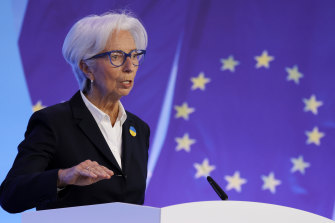Opinion
The threat of Europe breaking apart is rising as old ghosts emerge
Stephen Bartholomeusz
Senior business columnistIf you thought the US Federal Reserve Board or Reserve Bank were facing some tough decisions, then spare some pity for the European Central Bank, where the rise in European inflation rates and the need to raise interest rates poses a threat to the stability of the eurozone.
The ECB has, since the financial crisis, run one of the most aggressive monetary policies of any of the major central banks. Its policy rates have been below zero and it has bought about €6.5 trillion ($9.9 trillion) of bonds since it started a quantitative easing program in 2015 to keep interest rates in the eurozone at or below zero.

ECB president Christine Lagarde has little choice but to become more aggressive in the fight against inflation.Credit:Getty
All that is about to change. With inflation above 8 per cent the ECB has no option but to raise interest rates and end its bond-buying. Its president, Christine Lagarde, has said there will be a rate rise at the next ECB meeting next month and that the QE program will end on July 1.
While it is behind the Fed and RBA in responding to the global post-pandemic outbreak of the highest global inflation rates in decades – a surge exacerbated by the impact of Russia’s invasion of Ukraine on energy and food prices, which hits European economies highly dependent on Russian energy hardest – the ECB is essentially doing similar things for similar reasons.
The key difference in the challenges confronting the central banks is that, while 19 members of the European Union have the euro as their common currency, their central bank has to deal with 19 different economies. Some of those economies – and it tends to be a split between the norther and southern European states – have little in common.
It was that difference that, in the aftermath of the 2008 financial crisis, nearly tore the eurozone apart.
In the 2010-11 period there was a very real threat that a heavily-indebted Greece would be forced out, or choose to exit, the eurozone. It took several attempts until it was eventually bailed out by a coalition of the International Monetary Fund, the ECB, other eurozone economies and private investors.
Italy, Spain and Portugal were also on the brink, with the combination of very high levels of government debt, weak economies and banking systems plagued by bad debts and dangerously over-sized holdings of their own, distressed, governments’ bonds.
As recently as 2018 Italy, the third-largest economy in the EU, was threatening to exit the eurozone.
Unlike the northern European economies, its GDP was still below pre-crisis levels, unemployment remained at staggeringly high levels and the success of eurosceptic parties at the elections that year meant an exit appeared a realistic prospect. Had it occurred, it would have been a massive blow to eurozone cohesion and the future of the “European Project”.
The threat of renewed pressure for a “Grexit” and “Quitaly” has re-emerged with the turning point in the ECB’s monetary policies.
The surge in inflation in Europe and the response it dictates from the ECB is highlighting and exacerbating flaws in the European Project.
While the southern European economies and banks are in far better shape than they were in 2008 after significant pan-eurozone banking reforms, Greece and Italy remain heavily indebted and their economies relatively weak and therefore susceptible to a sudden surge in interest rates.
Italy’s debt-to-GDP ratio is pushing towards 150 per cent Greece’s towards 200 per cent even as rates are rising and economic growth is slowing across the eurozone. Stagflation – a recession in Europe even as inflation and therefore interest rates remain high – appears likely.
The yields on Italian and Greek government bonds in debt markets are already rising rapidly. Yields on Italy’s 10-year bonds were around 1.2 per cent at the start of this year but are now above 4 per cent. Greek government bonds had yields of about 1.3 per cent at the start of the year but now yield 4.7 per cent.
As those debts mature they will have to be refinanced at much higher rates, within weaker economies, and, once the ECB’s asset purchases end on July 1, without the support of the ECB’s bond-buying.
The intensifying pressure on the two weakest southern European economies – Spain and Portugal are in much stronger shapes than they were a decade ago – has resurfaced the threat to the eurozone itself.
At this point that threat isn’t acute but the renewed discussion about the potential for “fragmentation” of the eurozone signals that the pressures are building.
The keenly-watched relationships between the yields on Greek and Italian bonds and those of Germany’s are trending in the wrong direction.
At the start of the year, when Germany’s bonds were trading at negative yields, the spread between German and Italian 10-year bond yields was just under 1.4 percentage points and, for Greek bonds, 1.5 percentage points. This week those spreads have blown out to more than 2.4 percentage points and 2.9 percentage points respectively.

The Italian and Greek economies are particularly vulnerable to interest rate rises.Credit:Getty Images
While those are a long way short of the five percentage points experienced during the worst of the eurozone debt crises (which Mario Draghi cooled with his “whatever it takes” promise in mid-2012) they are the widest since the onset of the pandemic and are swelling quickly.
Lagarde is conscious of the threat even as she has committed the ECB to ending QE and raising eurozone interest rates at each of the next two meetings. She has indicated there will be a 25 basis point increase next month and potentially a bigger increase in September.
She has promised to fight “unwarranted” fragmentation of the eurozone and said the ECB will deploy its existing tools and new tools if necessary to avoid severe divergence of the financial conditions within the eurozone, although no-one seems at all sure what those “new tools” might be.
In the past episodes, the stronger northern European economies have resisted efforts to mutualise the debts of the southern economies.
The structural vulnerabilities in the eurozone – the members share a common currency and a free trade and travel zone but retain their economic and political sovereignty – that were exposed during and after the financial crisis haven’t been resolved and therefore the divergent nature of their economies threatens the stability of the zone during periods of stress.
The surge in inflation in Europe and the response it dictates from the ECB is highlighting and exacerbating those flaws in the European Project. The ECB will probably muddle through, as it as before, but there may be some awkward and tense moments before the threat of fragmentation subsides.
The Business Briefing newsletter delivers major stories, exclusive coverage and expert opinion. Sign up to get it every weekday morning.